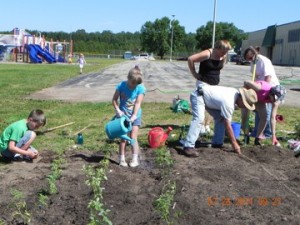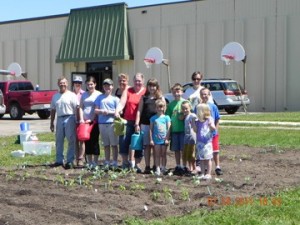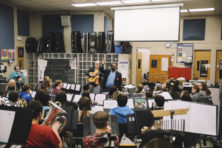Southern Door School’s Learning Garden
- Share
- Tweet
- Pin
- Share
It isn’t a Victory Garden straight out of World War II. It won’t feed hundreds of people. Southern Door’s Schoolyard Garden will, however, teach students about plants and cultivate a bond in the community.
Wendy Rivkin sits on the committee that helped create the garden. She thinks the garden will benefit the students as well as the rest of the community.

Heath Kennedy, Josie Kennedy, Laura Kennedy, Bob DeKelver
(bending to plant), Barb Schreiner-Schmidt (bending to plant), and Deb Kluth planting, watering and measuring for the Southern Door Schoolyard Garden. Photo by Wendy Rivkin.
Located near the main playground on the grounds of Southern Door School, the garden is 36 feet by 18 feet. This piece is just the first of what Rivkin hopes will be more plots in the future.
The idea started from a farmer’s market the elementary students hold. It’s what Rivkin called a “fake” farmer’s market, but it spawned the concept of the schoolyard garden.
“The schoolyard garden is something that’s new to us, but a lot of schools are doing it and benefiting from it,” she said.
Once the idea was hatched, one teacher after another said they could find ways to integrate the garden into their teaching.
The Family and Consumer Economics (FACE) department will use produce from the garden, while elementary students will learn how plants grow through observation.
The community service aspect of the garden comes from its volunteers. Students, teachers and community members will take care of the garden, bringing everyone together for a common cause.

Workers proudly survey the results of their labor at the Southern Door Schoolyard Garden. (From leftBob DeKelver, Barb Schreiner-Schmidt, Sophie Kennedy, Phoebe Kennedy, Laura Kennedy, Pamela Parks, Helen Parks, Josie Kennedy, Heath Kennedy, Andrew Kluth, Deb Kluth, Trey Kluth, Evelyn Parks proudly survey the results of their labor. (not pictured, Wendy Rivkin). Photo by Wendy Rivkin.
Additionally, service groups such as the Cub Scouts can use the garden to earn a badge and gain gardening experience. The school will also donate surplus food to local charities, helping those in need.
Rivkin said the garden’s mission is to “foster and grow the natural curiosity of children and connect them with food through gardening in a simple yet fascinating experience.”
Eventually, Rivkin said volunteers would start canning the produce, but for now the soil is in and planting has already begun.
The committee members hope to keep the garden around through fundraising and collecting donations. Rivkin referred to the garden as an “all-community cooperative” where people could donate materials, supplies and their time.
“It’s all about bringing the community together,” she said.


